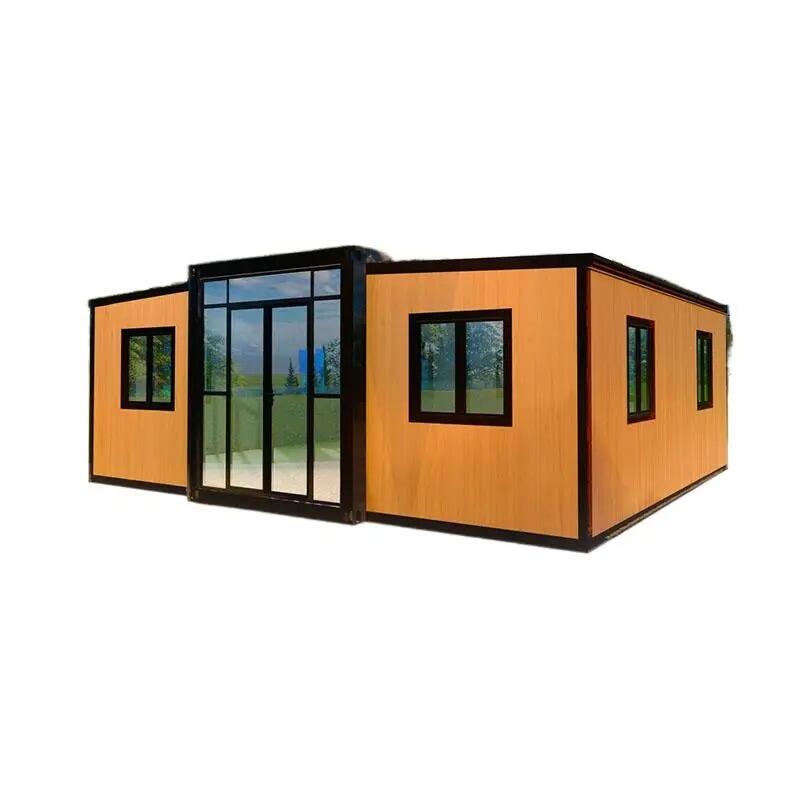Innovative Telescoping Design
Telescoping designs revolutionize the concept of space savings in dual-wing expandable container houses. These mechanisms work by enabling sections of the house to slide over each other seamlessly, increasing the living area when needed. This design offers significant space efficiency by compacting the home into a smaller footprint during transportation and expanding to provide ample living space once deployed. Telescoping designs are highly valued in the industry for maximizing space without compromising on functionality or comfort.
The benefits of a telescoping design are manifold. Primarily, it allows for maximum space utilization in a minimal footprint, making these homes ideal for urban or remote locations where space is a premium. Not only does this design maximize the living area, but it also contributes to the lightweight and portable nature of container houses. As a representative from the Prefab Housing Association puts it, "Telescoping designs offer a dynamic solution to space optimization in prefabricated homes, allowing for the most efficient use of space available without sacrificing quality or comfort."
Structural Integrity and Durability
The structural integrity and durability of dual-wing mechanisms are crucial for the longevity and safety of expandable container houses. These homes often feature materials such as high-strength steel for the framework and weather-resistant finishes that can withstand various environmental conditions. Construction techniques focus on reinforcing connections and stress points to ensure these movable homes maintain their integrity over time, despite frequent expansions and contractions.
Industry standards dictate strict durability and maintenance requirements, ensuring that these homes meet safety guidelines and remain functional over long periods. According to the International Code Council, prefab housing must meet specific criteria for wind and seismic resistance, often reaching fire protection level B and earthquake resistance level 8. Addressing concerns about wear and tear, the use of advanced materials and superior construction methods ensures these homes are both robust and reliable.
Space Optimization Strategies
Effective space optimization is at the heart of the design philosophy for expandable container homes. Innovative strategies, including the use of multi-functional furniture, help maximize the available space without compromising comfort. For instance, Murphy beds and expandable dining tables can be employed to create flexible spaces that adapt to different needs throughout the day. These design strategies not only provide practical solutions but also ensure aesthetic appeal, meeting the demands of modern consumers who value both form and function.
Real-world applications demonstrate the success of these strategies. A case study by Modular Architecture Review showcased a container home that utilized hidden storage compartments and convertible furniture to triple its functional space, thereby enhancing its livability without increasing its footprint. The combination of clever spatial design and tasteful decor ensures that these homes remain attractive to those seeking a balance between efficiency and style.
In summary, whether employing telescopic mechanisms, utilizing durable materials, or integrating space-saving designs, dual-wing expandable container houses present a viable living solution that merges innovation with practicality. These homes exemplify modern architectural prowess by offering adaptable housing solutions for various lifestyles and environments.
Modular Interior Configurations
Modular interior configurations are essential in crafting personalized living spaces within modular homes. They offer flexibility, enabling homeowners to adapt layouts that suit diverse lifestyles and specific needs. From movable walls to adaptable room arrangements, these configurations allow for seamless space transitions. According to customer surveys, many prefer modular interiors because they can be easily modified to accommodate changing circumstances, such as the addition of a new family member or the need for a home office. This adaptability also ensures scalability for future expansions, meaning that as needs evolve, the living space can evolve too without the need for drastic structural changes.
Exterior Aesthetic Customization
When it comes to the exterior of expandable container houses, customization presents endless possibilities. Options range from selecting unique colors and finishes to choosing specific materials that align with personal preferences. Several success stories reveal how aesthetically pleasing container homes have not only satisfied homeowners’ creative desires but also complied with community regulations, leading to greater neighborhood acceptance. Aesthetic choices significantly impact property values, often enhancing them as beautifully designed homes tend to attract more interest in the real estate market. An appealing exterior also elevates the overall ambiance, creating inviting spaces that reflect the homeowner's individuality.
Multi-Functional Space Adaptations
The concept of multi-functional spaces transforms traditional layouts into versatile living areas, a vital feature in tiny homes and container houses. Experts emphasize that adaptable environments provide long-term benefits, including increased functionality and efficient use of space. For instance, a living room can double as a home office or a workout area, offering a dynamic environment that caters to various needs without the need for additional construction. This adaptability, seen in many container homes, is particularly beneficial in maximizing limited spaces. The ability to reconfigure and redesign spaces ensures they remain relevant and practical over time, meeting both current and future demands of homeowners.
Sustainable Construction Practices
Energy-Efficient Systems Integration
Integrating energy-efficient systems into container homes is crucial for creating sustainable living environments. By focusing on advanced heating and cooling systems, we can drastically reduce energy consumption. According to a study by the International Energy Agency, energy-efficient systems can cut heating and cooling energy use by up to 50%. Case studies from companies like Tesla reveal successful implementations where homes have achieved significant reductions in energy usage, showcasing how efficient systems can result in both environmental and financial savings. These systems not only lower the carbon footprint but also enhance the living comfort within container homes, making them an attractive option for eco-conscious homeowners.
Eco-Friendly Material Selection
Selecting eco-friendly materials in construction is essential for ensuring healthier living spaces and promoting environmental sustainability. Key benefits include improved air quality and reduced environmental impact. For example, bamboo, reclaimed wood, and recycled steel are commonly used sustainable materials in the construction of container homes. Experts from the Green Building Council emphasize that using sustainable materials can lead to long-term cost savings, as these materials often require less maintenance and replacement. Additionally, homes built with eco-friendly materials are more durable and resilient, offering both immediate and lasting advantages to homeowners who prioritize sustainable living.
Waste Reduction Techniques
Implementing waste reduction techniques during the construction of expandable homes is pivotal for minimizing environmental impact. Effective methods include modular design, which allows for precise material use, and the recycling of offcuts and construction debris. Research by the Environmental Protection Agency shows that such practices can decrease construction waste by 30%. For best practices, modular housing sectors can focus on optimizing material selection and implementing on-site recycling efforts, thus reducing landfill contributions and promoting a circular economy. These strategies not only benefit the environment but also lead to cost savings during the construction and deployment phases.
Mobile Home and Tiny Home Solutions
Expandable container houses are revolutionizing the mobile and tiny home markets by providing flexible living solutions to meet diverse lifestyle needs. These homes bridge the gap between traditional mobile homes and tiny homes by offering customizable options that cater to personal preferences. According to industry experts, the demand for such housing solutions is driven by factors like affordability, mobility, and sustainability. For instance, an Amazon's tiny home, customizable and easy to assemble, exemplifies this new wave of practicality and adaptability.
The appeal of container houses extends beyond just their innovative design. Anecdotes and testimonials from tiny home enthusiasts illustrate the joy of living more simply yet luxuriously. One owner mentioned how their home’s minimalist aesthetic and functionality have significantly enhanced their living experience. This adaptability also supports various lifestyles, from young professionals seeking mobility to retirees desires tranquility in a downsized setting. These container homes allow personalization, thus offering a genuine sense of home in an increasingly mobile world.
Commercial Modular Installations
In the commercial realm, modular installations stand as a testament to efficiency and agility, offering businesses a cost-effective alternative to traditional construction. Companies in sectors like healthcare and education benefit greatly from the flexibility modular units provide. For example, a healthcare provider might use modular units for temporary clinics, showcasing adaptability and reducing traditional building costs. In education, quick classroom expansions are possible, accommodating fluctuating student populations efficiently.
However, embracing modular installations often involves navigating regulatory challenges. Understanding local building codes and compliance requirements is crucial for businesses looking to implement these solutions. Many regions have begun adapting regulations to facilitate the integration of modular buildings, but working closely with architects and local authorities can help overcome hurdles. The future of modular construction looks promising as regulatory frameworks evolve to support this innovative approach to efficient business operations.
Rapid Deployment Emergency Housing
Container homes serve an invaluable role in rapid deployment emergency housing, offering quick and efficient shelter solutions during disasters. Their sturdy structures and rapid assembly capabilities make them ideal for deployment in disaster-stricken areas where time is of the essence. In fact, data from disaster response organizations points to the effectiveness of modular homes in providing immediate relief in areas affected by natural calamities like hurricanes and earthquakes.
Case studies post-disaster sometimes showcase how these homes have been swiftly deployed to help those in need. In one such instance, after a severe flood, numerous container homes were erected within days, providing urgently needed shelter and aiding in recovery efforts. This capability not only highlights their practicality but also emphasizes their potential in humanitarian initiatives. As climate challenges continue, container homes are poised to be a crucial asset in global disaster response strategies.
Cost Comparison with Traditional Housing
Container homes offer a remarkable cost advantage compared to traditional housing, presenting an attractive option for many potential homeowners. Traditional homes often require significant investment in materials, labor, and time, whereas container homes utilize prefabricated materials that come ready for assembly. This streamlined process reduces both labor costs and construction time substantially. According to industry reports, container homes can cost between 20% to 60% less than traditional homes, depending on size and customization levels. This noticeable reduction has encouraged many individuals to make the switch, as evidenced by testimonials from homeowners who have transitioned from conventional housing to container homes, appreciating not only the cost savings but also the modern and flexible design options available.
Reduced Shipping and Assembly Costs
The economic benefits of container homes extend beyond initial construction. These homes are renowned for their reduced shipping and assembly costs due to their compact, modular nature. Unlike traditional homes that require numerous shipments of varied materials, container homes arrive in a single package, ready for quick assembly. This efficiency translates to substantial savings in logistics; studies show up to a 50% reduction in shipping and assembly expenses. Case studies of container home projects underscore significant savings in time and resources, bolstering their appeal as a cost-effective housing solution. For example, a community development project in Australia realized a 30% reduction in overall budget by utilizing container homes, reflecting the practical advantages of this innovative construction method.
Long-Term Financial Benefits
Investing in container homes offers considerable long-term financial benefits, appealing to both homeowners and real estate investors alike. One of the key advantages is their potential appreciation in value, as the market for sustainable, flexible housing options continues to grow. Financial analysts forecast a positive trend in the appreciation of container homes, given the increasing interest in affordable and adaptable housing solutions. Recommendations from experts suggest that individuals looking to diversify their real estate portfolio should consider container homes, as they offer not just potential equity gains but also savings on maintenance costs. Interviews with homeowners reveal satisfaction with these homes’ durability and low upkeep, making them a wise financial choice over the years.
Table of Contents
-
Sustainable Construction Practices
- Energy-Efficient Systems Integration
- Eco-Friendly Material Selection
- Waste Reduction Techniques
- Mobile Home and Tiny Home Solutions
- Commercial Modular Installations
- Rapid Deployment Emergency Housing
- Cost Comparison with Traditional Housing
- Reduced Shipping and Assembly Costs
- Long-Term Financial Benefits

